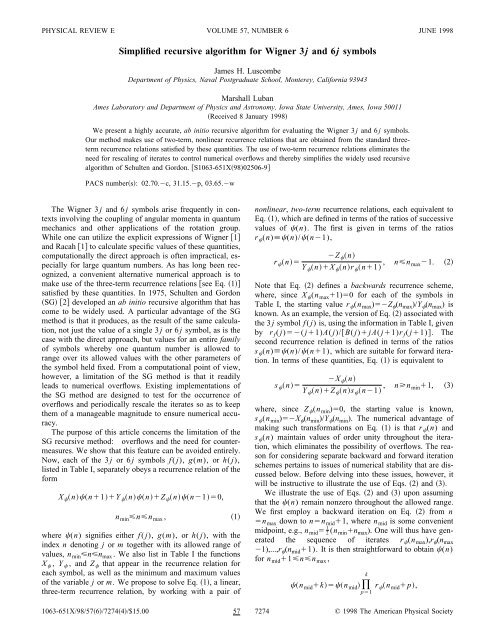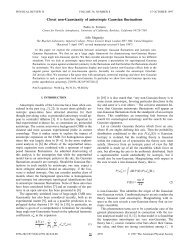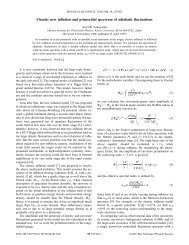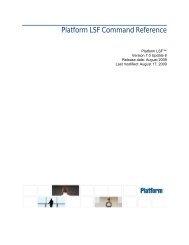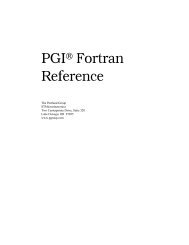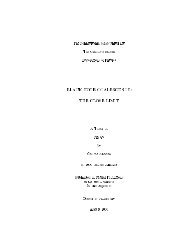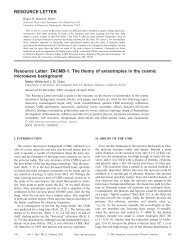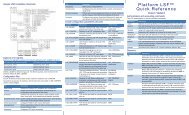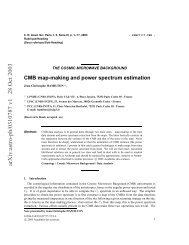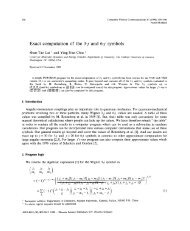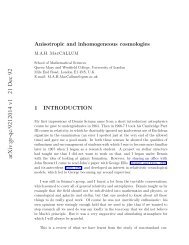Simplified recursive algorithm for Wigner 3j and 6j symbols - iucaa
Simplified recursive algorithm for Wigner 3j and 6j symbols - iucaa
Simplified recursive algorithm for Wigner 3j and 6j symbols - iucaa
Create successful ePaper yourself
Turn your PDF publications into a flip-book with our unique Google optimized e-Paper software.
PHYSICAL REVIEW E VOLUME 57, NUMBER 6<br />
JUNE 1998<br />
<strong>Simplified</strong> <strong>recursive</strong> <strong>algorithm</strong> <strong>for</strong> <strong>Wigner</strong> <strong>3j</strong> <strong>and</strong> <strong>6j</strong> <strong>symbols</strong><br />
James H. Luscombe<br />
Department of Physics, Naval Postgraduate School, Monterey, Cali<strong>for</strong>nia 93943<br />
Marshall Luban<br />
Ames Laboratory <strong>and</strong> Department of Physics <strong>and</strong> Astronomy, Iowa State University, Ames, Iowa 50011<br />
Received 8 January 1998<br />
We present a highly accurate, ab initio <strong>recursive</strong> <strong>algorithm</strong> <strong>for</strong> evaluating the <strong>Wigner</strong> 3 j <strong>and</strong> 6 j <strong>symbols</strong>.<br />
Our method makes use of two-term, nonlinear recurrence relations that are obtained from the st<strong>and</strong>ard threeterm<br />
recurrence relations satisfied by these quantities. The use of two-term recurrence relations eliminates the<br />
need <strong>for</strong> rescaling of iterates to control numerical overflows <strong>and</strong> thereby simplifies the widely used <strong>recursive</strong><br />
<strong>algorithm</strong> of Schulten <strong>and</strong> Gordon. S1063-651X9802506-9<br />
PACS numbers: 02.70.c, 31.15.p, 03.65.w<br />
The <strong>Wigner</strong> 3 j <strong>and</strong> 6 j <strong>symbols</strong> arise frequently in contexts<br />
involving the coupling of angular momenta in quantum<br />
mechanics <strong>and</strong> other applications of the rotation group.<br />
While one can utilize the explicit expressions of <strong>Wigner</strong> 1<br />
<strong>and</strong> Racah 1 to calculate specific values of these quantities,<br />
computationally the direct approach is often impractical, especially<br />
<strong>for</strong> large quantum numbers. As has long been recognized,<br />
a convenient alternative numerical approach is to<br />
make use of the three-term recurrence relations see Eq. 1<br />
satisfied by these quantities. In 1975, Schulten <strong>and</strong> Gordon<br />
SG 2developed an ab initio <strong>recursive</strong> <strong>algorithm</strong> that has<br />
come to be widely used. A particular advantage of the SG<br />
method is that it produces, as the result of the same calculation,<br />
not just the value of a single 3 j or 6 j symbol, as is the<br />
case with the direct approach, but values <strong>for</strong> an entire family<br />
of <strong>symbols</strong> whereby one quantum number is allowed to<br />
range over its allowed values with the other parameters of<br />
the symbol held fixed. From a computational point of view,<br />
however, a limitation of the SG method is that it readily<br />
leads to numerical overflows. Existing implementations of<br />
the SG method are designed to test <strong>for</strong> the occurrence of<br />
overflows <strong>and</strong> periodically rescale the iterates so as to keep<br />
them of a manageable magnitude to ensure numerical accuracy.<br />
The purpose of this article concerns the limitation of the<br />
SG <strong>recursive</strong> method: overflows <strong>and</strong> the need <strong>for</strong> countermeasures.<br />
We show that this feature can be avoided entirely.<br />
Now, each of the 3 j or 6 j <strong>symbols</strong> f ( j), g(m), or h(j),<br />
listed in Table I, separately obeys a recurrence relation of the<br />
<strong>for</strong>m<br />
X nn1Y nnZ nn10,<br />
n min nn max ,<br />
where (n) signifies either f ( j), g(m), or h(j), with the<br />
index n denoting j or m together with its allowed range of<br />
values, n min nn max . We also list in Table I the functions<br />
X , Y , <strong>and</strong> Z that appear in the recurrence relation <strong>for</strong><br />
each symbol, as well as the minimum <strong>and</strong> maximum values<br />
of the variable j or m. We propose to solve Eq. 1, a linear,<br />
three-term recurrence relation, by working with a pair of<br />
1<br />
nonlinear, two-term recurrence relations, each equivalent to<br />
Eq. 1, which are defined in terms of the ratios of successive<br />
values of (n). The first is given in terms of the ratios<br />
r (n)(n)/(n1),<br />
Z n<br />
r n<br />
Y nX nr n1 , nn max1. 2<br />
Note that Eq. 2 defines a backwards recurrence scheme,<br />
where, since X (n max 1)0 <strong>for</strong> each of the <strong>symbols</strong> in<br />
Table I, the starting value r (n max )Z (n max )/Y (n max )is<br />
known. As an example, the version of Eq. 2 associated with<br />
the 3 j symbol f ( j) is, using the in<strong>for</strong>mation in Table I, given<br />
by r f ( j)(j1)A(j)/B(j)jA(j1)r f (j1). The<br />
second recurrence relation is defined in terms of the ratios<br />
s (n)(n)/(n1), which are suitable <strong>for</strong> <strong>for</strong>ward iteration.<br />
In terms of these quantities, Eq. 1 is equivalent to<br />
X n<br />
s n<br />
Y nZ ns n1 , nn min1, 3<br />
where, since Z (n min )0, the starting value is known,<br />
s (n min )X (n min )/Y (n min ). The numerical advantage of<br />
making such trans<strong>for</strong>mations on Eq. 1 is that r (n) <strong>and</strong><br />
s (n) maintain values of order unity throughout the iteration,<br />
which eliminates the possibility of overflows. The reason<br />
<strong>for</strong> considering separate backward <strong>and</strong> <strong>for</strong>ward iteration<br />
schemes pertains to issues of numerical stability that are discussed<br />
below. Be<strong>for</strong>e delving into these issues, however, it<br />
will be instructive to illustrate the use of Eqs. 2 <strong>and</strong> 3.<br />
We illustrate the use of Eqs. 2 <strong>and</strong> 3 upon assuming<br />
that the (n) remain nonzero throughout the allowed range.<br />
We first employ a backward iteration on Eq. 2 from n<br />
n max down to nn mid 1, where n mid is some convenient<br />
midpoint, e.g., n mid 1 2 (n min n max ). One will thus have generated<br />
the sequence of iterates r (n max ),r (n max<br />
1),...,r (n mid 1). It is then straight<strong>for</strong>ward to obtain (n)<br />
<strong>for</strong> n mid 1nn max ,<br />
n mid kn mid r n mid p,<br />
p1<br />
k<br />
1063-651X/98/576/72744/$15.00 57 7274 © 1998 The American Physical Society
57 SIMPLIFIED RECURSIVE ALGORITHM FOR WIGNER ...<br />
7275<br />
TABLE I. Parameters <strong>for</strong>, <strong>and</strong> constituents of, the three-term recurrence relations satisfied by the 3 j <strong>and</strong> 6 j <strong>symbols</strong>, as represented by<br />
Eq. 1. In each case, all parameters except the variable j or m are held fixed. Also listed are the normalization condition <strong>and</strong> sign convention<br />
<strong>for</strong> each symbol. We use the notation of Ref. 2.<br />
3 j or 6 j<br />
symbol <br />
fj<br />
j j 2 j 3<br />
m 2 m 3 m 2<br />
m 3<br />
gm j 1<br />
j 2<br />
m 1 m<br />
j 3<br />
mm 1<br />
<br />
hj j<br />
l 1<br />
j 2<br />
l 2<br />
j 3<br />
l 3<br />
<br />
Variable j m j<br />
X jA(j1) C(m1) jE(j1)<br />
Y B(j) D(m) F(j)<br />
Z (j1)A(j) C(m) (j1)E(j)<br />
Ajj 2 j 2 j 3 2 j 2 j 3 1 2 j 2 <br />
Cmj 2 m1j 2 m<br />
E j j 2 j 2 j 3 2 <br />
j 2 m 2 m 3 2 1/2<br />
j 3 mm 1 1<br />
j 2 j 3 1 2 j 2 <br />
j 3 mm 1 1/2<br />
j 2 l 2 l 3 2 <br />
Functions<br />
B j2 j1m 2 m 3 <br />
Dmj 2 j 2 1j 3 j 3 1<br />
l 2 l 3 1 2 j 2 1/2<br />
Fj2j1jj1jj1<br />
j 2 j 2 1j 3 j 3 1<br />
j 1 j 1 1<br />
j 2 j 2 1j 3 j 3 1<br />
m 2 m 3 jj1<br />
2mmm 1 <br />
2l 1 l 1 1l 2 l 2 1<br />
jj1j 2 j 2 1<br />
j 3 j 3 1l 3 l 3 1<br />
jj1j 2 j 2 1<br />
j 3 j 3 1<br />
End points j min max(j 2 j 3 ,m 2 m 3 ) m min max(j 2 ,j 3 m 1 ) j min max(j 2 j 3 ,l 2 l 3 )<br />
j max j 2 j 3 m max min(j 2 ,j 3 m 1 ) j max min(j 2 j 3 ,l 2 l 3 )<br />
Normalization<br />
j<br />
max<br />
jjmin2j1f<br />
2 m<br />
j1 2j 1 1 max<br />
mmming<br />
2 m1 (2l 1 1) jjmin(2j1)h<br />
2 (j)1<br />
j max<br />
Sign sgnf(j max )(1) j 2 j 3 m 2 m 3 sgng(m max )(1) j 2 j 3 m 1 sgnh(j max )(1) j 2 j 3 l 2 l 3<br />
1kn max n mid .<br />
Of course, the value of (n mid ) is presently unknown; it will<br />
be determined shortly through normalization. We now iterate<br />
Eq. 3 from nn min up to nn mid 1; this produces the<br />
iterates s (n min ),s (n min 1),...,s (n mid 1). From these<br />
quantities we obtain (n) <strong>for</strong> n min nn mid 1,<br />
n mid kn mid s n mid p,<br />
p1<br />
1kn mid n min .<br />
With the combined equations 4 <strong>and</strong> 5, we have thus determined<br />
the (n) up to an unknown multiplicative factor<br />
(n mid ). The magnitude of this factor is readily determined<br />
by imposing the normalization conditions given in Table I.<br />
We then utilize the phase in<strong>for</strong>mation listed in Table I to<br />
completely determine (n) <strong>for</strong> all n. As an example, we<br />
show in Fig. 1 the result of applying this simple <strong>algorithm</strong> to<br />
obtain the family of 3 j <strong>symbols</strong>,<br />
k<br />
4<br />
5<br />
f j<br />
j<br />
15<br />
100<br />
70<br />
60<br />
,<br />
55<br />
which remains nonzero over the allowed range 40 j160.<br />
The 3 j <strong>and</strong> 6 j <strong>symbols</strong>, of course, can <strong>and</strong> do vanish <strong>for</strong><br />
selected values of their parameters. If, say, (n 0 )0,<br />
r (n 0 1) <strong>and</strong> s (n 0 1) are undefined. We must there<strong>for</strong>e<br />
modify the above <strong>algorithm</strong> to account <strong>for</strong> this possibility,<br />
<strong>and</strong> we will be guided by the following observations. Examining<br />
Fig. 1, we note the resemblance between f ( j) <strong>and</strong> a<br />
one-dimensional bound quantum eigenstate. This is a generic<br />
feature of the 3 j <strong>and</strong> 6 j <strong>symbols</strong>; we use f ( j) merely as an<br />
illustration. Now, it is known, from the semiclassical theory<br />
of the 3 j <strong>and</strong> 6 j <strong>symbols</strong> 3, that the range of allowed<br />
quantum numbers, n min nn max , can be divided into the<br />
following subranges: a ‘‘classical’’ region n I nn II <strong>and</strong><br />
two complementary ‘‘nonclassical’’ regions n min nn I <strong>and</strong><br />
n II nn max . The classical region is defined as the set of<br />
quantum numbers <strong>for</strong> which it is possible to construct a vector<br />
diagram showing the coupling of the angular momentum<br />
vectors; in the nonclassical regimes, such vector diagrams do<br />
not exist 4. The limits of the classical region, n I <strong>and</strong> n II ,
7276 JAMES H. LUSCOMBE AND MARSHALL LUBAN<br />
57<br />
FIG. 1. Values <strong>for</strong> the family of 3 j <strong>symbols</strong>, f ( j)<br />
j 100<br />
( 15 70<br />
60 55 ), over the entire range of allowed j values, 40 j<br />
160. In the classical region, j I j j II , where here j I 49 <strong>and</strong><br />
j II 98 shown as dashed lines, f ( j) has an oscillatory character; in<br />
the nonclassical regions, f ( j) decays monotonically. There are are<br />
25 orders of magnitude difference between the largest <strong>and</strong> smallest<br />
values in this family of 3 j <strong>symbols</strong>.<br />
are determined as the roots of a certain determinant, known<br />
as the Cayley determinant 3. For the parameters of Fig. 1,<br />
these are shown as dashed lines. The important point is that,<br />
in analogy with a bound eigenstate, in the classical region the<br />
3 j <strong>and</strong> 6 j <strong>symbols</strong> have an oscillatory character, whereas in<br />
the nonclassical regions, they are monotonically decaying<br />
3. Depending on the width of the nonclassical regions,<br />
there can be many orders of magnitude difference between<br />
the smallest values of (n) found at n max <strong>and</strong> n min <strong>and</strong><br />
the largest values, which occur in the classical region. In Fig.<br />
1, <strong>for</strong> example, there are some 25 orders of magnitude difference<br />
between the largest <strong>and</strong> smallest values in this family<br />
of 3 j <strong>symbols</strong>.<br />
These considerations are relevant <strong>for</strong> the following reasons.<br />
In numerical treatments of the one-dimensional Schrödinger<br />
equation, one employs the st<strong>and</strong>ard finite-difference<br />
approximation to replace the continuous differential equation<br />
by a three-term recurrence relation. We note that, conversely,<br />
as discussed in Ref. 2, the three-term recurrence relations<br />
satisfied by the 3 j <strong>and</strong> 6 j <strong>symbols</strong> can be shown to originate<br />
from eigenvalue problems. Now, as is well known, threeterm<br />
recurrence relations possess two linearly independent<br />
solutions. If the desired physical solution of a recurrence<br />
relation is monotonically decreasing, as with the decay of<br />
(n) in its nonclassical regions, it is simple to show that the<br />
other, linearly independent solution will be monotonically<br />
increasing. Indeed, the source of the numerical instability<br />
associated with three-term recurrence relations is that 5 if<br />
one attempts to calculate a decaying solution of the recurrence<br />
relation by <strong>for</strong>ward iteration, the slightest round-off<br />
error will trigger the growth of the unwanted, linearly independent,<br />
diverging solution.<br />
There<strong>for</strong>e, in the nonclassical regions one must iterate the<br />
recurrence relation in the direction of increasing (n) to<br />
avoid the instability. These are also just the regions where<br />
overflows can develop. By contrast, in the classical region,<br />
where the solutions to the recurrence relation are oscillatory,<br />
there is no source of instability <strong>and</strong> one may safely iterate in<br />
either direction. The problem we seek to avoid in our ratiobased<br />
method is that of encountering an identically zero<br />
value of . The zeros of , however, if they occur, occur<br />
only in the classical region, where (n) is oscillatory. We<br />
there<strong>for</strong>e adopt a hybrid approach. We utilize the two-term<br />
recurrence relations 2 <strong>and</strong> 3 in the respective nonclassical<br />
regions <strong>and</strong> the three-term recurrence relation 1 in the classical<br />
region.<br />
For our purposes, however, precisely where one draws the<br />
line between the classical <strong>and</strong> nonclassical regions is not<br />
crucial; all that is important is that we stop iterating with<br />
Eqs. 2 <strong>and</strong> 3 somewhere in the classical region, be<strong>for</strong>e we<br />
encounter a zero of (n). We will there<strong>for</strong>e adopt the following<br />
convention. In iterating Eqs. 2 <strong>and</strong> 3, starting<br />
from n max <strong>and</strong> n min , respectively, we note that both r (n)<br />
<strong>and</strong> s (n) initially maintain values less than unity. Only<br />
when we reach the first local extremum of (n) dor <strong>and</strong> s <br />
first exceed unity. This provides a natural criterion <strong>for</strong> the<br />
locations of the boundaries <strong>and</strong> one that is simple to implement<br />
<strong>algorithm</strong>ically. We will denote the values of n where<br />
r (n) <strong>and</strong> s (n) first exceed unity having started from n max<br />
<strong>and</strong> n min by n <strong>and</strong> n , respectively. Specifically, we have<br />
r (n )1, but r (n 1)1.<br />
The modifications of Eqs. 4 <strong>and</strong> 5 then become<br />
<strong>and</strong><br />
n kn r n p,<br />
p1<br />
1kn max n ,<br />
n kn s n p,<br />
p1<br />
1kn n min ,<br />
k<br />
k<br />
4<br />
5<br />
where, as be<strong>for</strong>e, r <strong>and</strong> s are obtained from Eqs. 2 <strong>and</strong><br />
3, now <strong>for</strong> n nn max <strong>and</strong> n min nn , respectively. At<br />
this point, we have the unknown quantities in Eqs. (4) <strong>and</strong><br />
(5), (n ) <strong>and</strong> (n ). We can eliminate one of these<br />
unknowns in terms of the other as follows. Let us define two<br />
auxiliary sequences (n)(n)/(n ) <strong>and</strong> (n)<br />
(n)/(n ). These quantities obviously satisfy the same<br />
three-term recurrence relation 1. One can then use Eq. 1<br />
to iterate (n) in the <strong>for</strong>ward direction starting from n<br />
n , using the initial values (n 1)s (n 1) <strong>and</strong><br />
(n )1, up to some value of n, n c n , say. For convenience,<br />
we can take n c n if desired. Likewise, we can<br />
use Eq. 4 to iterate (n) in the backward direction starting<br />
from nn , using the initial values (n 1)<br />
r (n 1) <strong>and</strong> (n )1, down to nn c . The value of<br />
(n c ) derived from these two sequences must obviously be<br />
identical. This yields the connection between (n ) <strong>and</strong><br />
(n ), (n )/(n ) (n c )/ (n c ). Multiplying the<br />
(n) which have now been evaluated unambiguously <strong>for</strong><br />
n min nn c by (n )/(n ) thus leaves us with (n)<br />
<strong>for</strong> n min nn max ; i.e., we have determined (n) uptothe
57 SIMPLIFIED RECURSIVE ALGORITHM FOR WIGNER ...<br />
7277<br />
unknown multiplicative factor (n ). As be<strong>for</strong>e, we determine<br />
this factor by applying the normalization conditions<br />
<strong>and</strong> sign conventions given in Table I.<br />
In conclusion, we have presented a <strong>recursive</strong> <strong>algorithm</strong> to<br />
compute the <strong>Wigner</strong> 3 j <strong>and</strong> 6 j <strong>symbols</strong> that simplifies the<br />
well-known SG method. Our method is based on the use of<br />
nonlinear, two-term recurrence relations that are obtained<br />
from the st<strong>and</strong>ard three-term recurrence relations obeyed by<br />
the 3 j <strong>and</strong> 6 j <strong>symbols</strong>. By eliminating the programming<br />
overhead of having to check <strong>for</strong> near overflows <strong>and</strong> keeping<br />
track of rescaling factors, our <strong>algorithm</strong> provides a highly<br />
accurate, yet significantly simpler framework, with which to<br />
calculate these quantities.<br />
ACKNOWLEDGMENTS<br />
Ames Laboratory is operated <strong>for</strong> the U.S. Department of<br />
Energy by Iowa State University under Contract No. W-<br />
7405-Eng-82. We would like to acknowledge useful conversations<br />
with Scott Davis, I. Y. Lee, Xavier Maruyama, Frank<br />
Stevens, <strong>and</strong> Don Walters.<br />
1 E. P. <strong>Wigner</strong>, Group Theory Academic Press, New York,<br />
1959, p. 191; G. Racah, Phys. Rev. 62, 438 1942. A useful<br />
summary of the 3 j <strong>and</strong> 6 j <strong>symbols</strong> <strong>and</strong> the <strong>Wigner</strong>-Racah<br />
<strong>for</strong>mulas is given by A. Messiah, Quantum Mechanics North-<br />
Holl<strong>and</strong>, Amsterdam, 1962, Vol. II, Appendix C.<br />
2 K. Schulten <strong>and</strong> R. G. Gordon, J. Math. Phys. 16, 1961 1975.<br />
While the various three-term recurrence relations satisfied by<br />
the 3 j <strong>and</strong> 6 j <strong>symbols</strong> have been derived previously by several<br />
authors, Schulten <strong>and</strong> Gordon provide a useful, unified derivation<br />
of these recurrence relations.<br />
3 Semiclassical approximations are discussed in detail by G.<br />
Ponzano <strong>and</strong> T. Regge, in Spectroscopic <strong>and</strong> Group Theoretical<br />
Methods in Physics, edited by F. Bloch et al. North-<br />
Holl<strong>and</strong>, Amsterdam, 1968, pp. 1–58. Additional semiclassical<br />
results are derived by K. Schulten <strong>and</strong> R. G. Gordon, J.<br />
Math. Phys. 16, 1971 1975. Early work on the classical limits<br />
of the 3 j <strong>and</strong> 6 j <strong>symbols</strong> includes that of <strong>Wigner</strong> 1, Chap.<br />
27, <strong>and</strong> P. J. Brussaard <strong>and</strong> H. A. Tolhoek, Physica Amsterdam<br />
23, 955 1957.<br />
4 For many quantum-mechanically allowed 3 j <strong>and</strong> 6 j <strong>symbols</strong>,<br />
there do not exist vector diagrams showing the coupling of the<br />
angular momentum vectors. For example, consider<br />
2 j j j<br />
( 0 j j); this is but one example of a well-defined 3 j symbol<br />
of value (2 j)!/(4j1)! <strong>for</strong> which a vector addition<br />
diagram does not exist <strong>for</strong> j 2. 1 The ‘‘classical region’’ of<br />
the 3 j <strong>and</strong> 6 j <strong>symbols</strong> is defined as the set of quantum numbers<br />
<strong>for</strong> which vector diagrams do exist.<br />
5 See, <strong>for</strong> example, the discussion given by M. Luban <strong>and</strong> J. H.<br />
Luscombe, Phys. Rev. B 35, 9045 1987 <strong>and</strong> by W. H. Press,<br />
S. A. Teukolsky, W. T. Vetterling, <strong>and</strong> B. P. Flannery, Numerical<br />
Recipes Cambridge University Press, Cambridge, Engl<strong>and</strong>,<br />
1992, pp. 179–181.


